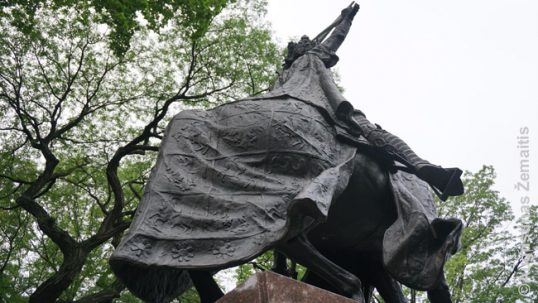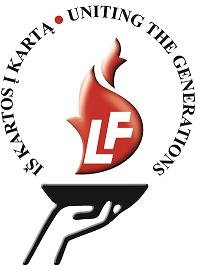Lithuanian minority heritage abroad
In addition to the ethnic Lithuanians, many people of Lithuania‘s ethnic minorities also emigrated over time with each wave of emigration. The most sizeable groups were Lithuania‘s Poles, Germans, and Jews.
„Global True Lithuania“ encyclopedia of Lithuanian heritage abroad defines the Lithuanian heritage sites not based on their relation to ethnic Lithuanians but rather on their relation to Lithuania. As such, numerous sites created by these ex-Lithuanian minorities are also included in the website.
However, it should be noted, that especially before World War I Lithuania‘s minorities typically did not consider themselves Lithuanian. After emigration, they kept no contact with Lithuanian communities but rather integrated into e.g. Polish-American, German-American, or Jewish-American communities.

Close-up of Jogaila with Vytis visible. This monument was built by Poles rather than Lithuanians
These large groups typically left no Lithuanian heritage sites after them, as they built and operated buildings and monuments together with people of the same ethnicity from elsewhere (e.g. together with Poles from Poland and Ukraine; together with Germans from Germany; together with Jews from Russia). It is thus impossible to distinguish these sites as Lithuanian heritage and they have nothing marking them as such. Read more here about the First Wave of Lithuanian emigration to understand better how and why Lithuania was divided by ethnicity that much at the time: http://www.truelithuania.com/first-wave-of-lithuanian-emigration-1865-1915-10260.
On the other hand, there were always exceptions. Some particular sites retained a visible connection to Lithuania, ranging from a memorial to Lithuanian king Jogaila (also a king of Poland) in New York Central Park that was built by Poles, or Vilna Shul in Boston (a Jewish synagogue named after Vilnius), or a Litvak synagogue in Sao Paulo (a city where synagogues were established based on the location Jews immigrated from).

Telshe Yeshiva entrance
Heritage of the Lithuania’s Poles (Polish-speaking Lithuanians) abroad
Most of the Lithuanian minority heritage abroad is Polish-Lithuanian heritage. Up until the 19th-20th century, there was no clear separation between Polish and Lithuanian nations and quite a lot of Lithuanians considered the Polish language and culture to be their own, even though they did not have any Polish blood in their veins. Today we would call them the Poles of Lithuania but back then they would usually introduce themselves as either Polish-speaking Lithuanians or both Polish and Lithuanians at the same time.
In the 18th and 19th centuries, the majority of Lithuania's nobility were such Polish speakers and until the 1860s, Lithuanian commoners rarely had any opportunities to emigrate or even travel at all (because they were serfs - a slave-like "property" of the local nobles). Therefore, the oldest Lithuanian heritage outside the former Polish-Lithuanian Commonwealth is related to the "noble" Lithuanian citizens, most of whom used the Polish language to write or speak in public.
During the period of 1569–1795, Poland and Lithuania were united as a single Commonwealth, thus a lot of Poland's heritage from that era is closely related to Lithuania. Lithuania - just like Poland itself - was also ruled from the Royal Palace of Warsaw, Lithuanian nobles would go there to participate in the sessions of the joint Polish-Lithuanian parliament in Poland (called Seimas in Lithuanian and Sejm in Polish), while the Polish kings buried in Wawel Castle of Krakow or Warsaw Cathedral also held the title of the Grand Dukes of Lithuania (and many of them were of Lithuanian origin).
The Polish-Lithuanian state participated in the matters of the whole of Europe. Its nobility was integrated with the nobility of Europe through marriages and other relationships that crossed the state borders, both former and current. Thus Lithuanian nobles left their imprints in Rome (the tomb of the first Lithuanian cardinal Radvila, or Radziwill), France (the city of Nancy was ruled by Stanislovas Leščinskis, or Stanisław Leszczyński, a former king of Poland-Lithuania), and Germany (namely Saxony, which was ruled by the Polish-Lithuanian monarchs for a while).
Lithuanian nobles living abroad became even more active during the “era of revolutions” of the late 18th century, as the Russian Empire annexed the Lithuania but was unable to destroy the hope for its liberation. The scattered freedom fighters gathered in Paris and some even ended up in the Americas. Some of the fighters such as Tadas Kosciuška, or Tadeusz Kościuszko in Polish, helped other revolutionaries to seek their freedom and, therefore, are respected even in far-away lands. The highest peak of Australia is named after Tadas Kosciuška (Mount Kosciuszko) and Chile has a mountain named in honor of Ignas Domeika / Ignacy Domeyko (La cordillera de Domeyko).
Later, less affluent Poles of Lithuania joined the First Wave of Emigration of the Lithuanian-speaking Lithuanians. They established their own settlements in America: towns named after Vilnius (using its Polish name Wilno) still exist in Canada (Ontario) and the USA (Minnesota).
Heritage of the Lithuania’s Jews abroad
The mass emigration of the Jews started back in the 19th century and continued all through the 20th century. Today the number of descendants of Lithuania’s Jews abroad is larger than the total number of Jews who have ever lived in Lithuania. Even though the majority of them integrated into a wider Jewish nation and barely maintained any relationship with Lithuania, some traces of Lithuania can still be found in their communities. A number of synagogues and yeshivas are named after locations of Lithuania: Vilna Shul (after Vilnius) in Boston, Ponevezh Yeshiva (after Panevėžys) in Israel, Telshe Yeshiva (after Telšiai) in the USA (the main one in Cleveland). These institutions were founded by the Jews who had emigrated from the respective Lithuanian cities.





